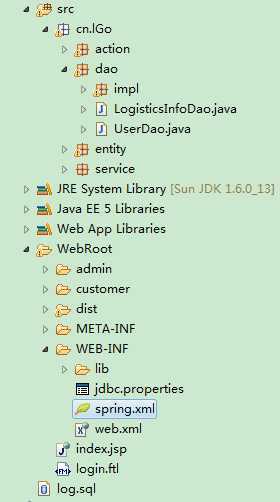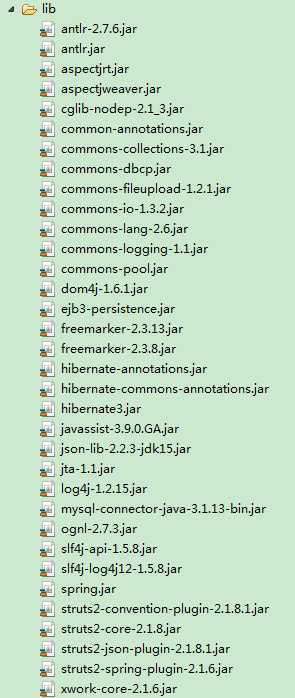spring+hibernate+Struts2 整合(全注解及注意事项)
时间:2014-05-07 19:44:39
收藏:0
阅读:565
最近帮同学做毕设,一个物流管理系统,一个点餐系统,用注解开发起来还是很快的,就是刚开始搭环境费了点事,今天把物流管理系统的一部分跟环境都贴出来,有什么不足的,请大神不吝赐教。
1、结构如下

2、jar包如下

3、首先是spring.xml
<?xml version="1.0" encoding="UTF-8"?> <beans xmlns="http://www.springframework.org/schema/beans" xmlns:xsi="http://www.w3.org/2001/XMLSchema-instance" xmlns:context="http://www.springframework.org/schema/context" xmlns:aop="http://www.springframework.org/schema/aop" xmlns:tx="http://www.springframework.org/schema/tx" xsi:schemaLocation="http://www.springframework.org/schema/beans http://www.springframework.org/schema/beans/spring-beans-2.5.xsd http://www.springframework.org/schema/context http://www.springframework.org/schema/context/spring-context-2.5.xsd http://www.springframework.org/schema/aop http://www.springframework.org/schema/aop/spring-aop-2.5.xsd http://www.springframework.org/schema/tx http://www.springframework.org/schema/tx/spring-tx-2.5.xsd"> <context:annotation-config /> <context:component-scan base-package="cn.lGo" /> <context:property-placeholder location="WEB-INF/jdbc.properties" /> <bean id="dataSource" destroy-method="close" class="org.apache.commons.dbcp.BasicDataSource"> <property name="driverClassName" value="${jdbc.driverClassName}" /> <property name="url" value="${jdbc.url}" /> <property name="username" value="${jdbc.username}" /> <property name="password" value="${jdbc.password}" /> </bean> <bean id="sf" class="org.springframework.orm.hibernate3.annotation.AnnotationSessionFactoryBean"> <property name="dataSource" ref="dataSource" /> <property name="packagesToScan"> <list> <value>cn.lGo.entity</value> </list> </property> <property name="hibernateProperties"> <props> <prop key="hibernate.dialect"> org.hibernate.dialect.MySQLDialect </prop> <prop key="hibernate.show_sql">true</prop> </props> </property> </bean> <bean id="hibernateTemplate" class="org.springframework.orm.hibernate3.HibernateTemplate"> <property name="sessionFactory" ref="sf"></property> </bean> <bean id="txManager" class="org.springframework.orm.hibernate3.HibernateTransactionManager"> <property name="sessionFactory" ref="sf" /> </bean> <!-- 配置事务特性 --> <tx:advice id="idAdvice" transaction-manager="txManager"> <tx:attributes> <tx:method name="find*" propagation="NOT_SUPPORTED" read-only="true" isolation="READ_COMMITTED" /> <tx:method name="save*" propagation="REQUIRED" isolation="READ_COMMITTED" /> <tx:method name="delete*" propagation="REQUIRED" isolation="READ_COMMITTED" /> <tx:method name="update*" propagation="REQUIRED" isolation="READ_COMMITTED" /> <!-- Action中execute,暂时先用REQUIRED,以后真对查询操作, 修改以后在使用NOT_SUPPORTED --> <tx:method name="*" propagation="REQUIRED" /> </tx:attributes> </tx:advice> <!-- Aop配置事务作用在那个位置:dao--> <aop:config> <aop:pointcut expression="execution (* cn.lGo.dao..*.*(..))" id="curd"/> <aop:advisor advice-ref="idAdvice" pointcut-ref="curd"/> </aop:config> </beans>
这个配置文件就不说了,在之前的文章中有提到过的。
4、web.xml
<?xml version="1.0" encoding="UTF-8"?> <web-app version="2.5" xmlns="http://java.sun.com/xml/ns/javaee" xmlns:xsi="http://www.w3.org/2001/XMLSchema-instance" xsi:schemaLocation="http://java.sun.com/xml/ns/javaee http://java.sun.com/xml/ns/javaee/web-app_2_5.xsd"> <display-name></display-name> <welcome-file-list> <welcome-file>login.ftl</welcome-file> </welcome-file-list> <context-param> <param-name>contextConfigLocation</param-name> <param-value>/WEB-INF/spring.xml</param-value> </context-param> <listener> <listener-class>org.springframework.web.context.ContextLoaderListener</listener-class> </listener> <filter> <filter-name>struts2</filter-name> <filter-class>org.apache.struts2.dispatcher.ng.filter.StrutsPrepareAndExecuteFilter</filter-class> </filter> <filter-mapping> <filter-name>struts2</filter-name> <url-pattern>/*</url-pattern> </filter-mapping> </web-app>
上述中:
<context-param> <param-name>contextConfigLocation</param-name> <param-value>/WEB-INF/spring.xml</param-value> </context-param> <listener> <listener-class>org.springframework.web.context.ContextLoaderListener</listener-class> </listener>
指的是在项目启动时加载spring的配置文件
<filter> <filter-name>struts2</filter-name> <filter-class>org.apache.struts2.dispatcher.ng.filter.StrutsPrepareAndExecuteFilter</filter-class> </filter> <filter-mapping> <filter-name>struts2</filter-name> <url-pattern>/*</url-pattern> </filter-mapping>
指的是配置使用struts2注解
5、一个实体类
package cn.lGo.entity; import javax.persistence.Entity; import javax.persistence.Id; import javax.persistence.Table; @Entity @Table(name="user") public class User { private Integer id; private String name; private String password; private String address; @Id public Integer getId() { return id; } public void setId(Integer id) { this.id = id; } public String getName() { return name; } public void setName(String name) { this.name = name; } public String getPassword() { return password; } public void setPassword(String password) { this.password = password; } public String getAddress() { return address; } public void setAddress(String address) { this.address = address; } }
其中要注意的问题是,如果数据库中有字段为user_name,而在实体类中写userName,是不会自动映射的,要加一个注解@Column(name="user_name")。
另外,还有一点实体类中使用hibernate注解时,不要使用数据库的敏感词
6、dao
package cn.lGo.dao; import java.util.List; import cn.lGo.entity.User; public interface UserDao { /** * 根据用户名查找对应用户 * @param userName * @return */ public List<User> findUserByName(String userName); }
7、daoImpl 实现类
package cn.lGo.dao.impl; import java.util.List; import javax.annotation.Resource; import org.springframework.orm.hibernate3.HibernateTemplate; import org.springframework.stereotype.Component; import cn.lGo.dao.UserDao; import cn.lGo.entity.User; @Component public class UserDaoImpl implements UserDao { private HibernateTemplate hibernateTemplate; public HibernateTemplate getHibernateTemplate() { return hibernateTemplate; } @Resource public void setHibernateTemplate(HibernateTemplate hibernateTemplate) { this.hibernateTemplate = hibernateTemplate; } @SuppressWarnings("unchecked") public List<User> findUserByName(String userName) { return hibernateTemplate.find("from User where name= ? ",new Object[]{userName}); } }
这个在spring注解呢篇中说过。
@Component 是将该类注册到spring中,如果没写属性,就会相当于 <bean name="userDaoImpl" ... 首字母小写
@Resource 注入,将sprin容器中name="hibernateTemplate"的 注入进去
8、service
package cn.lGo.service; import java.util.List; import javax.annotation.Resource; import org.springframework.stereotype.Component; import cn.lGo.dao.UserDao; import cn.lGo.entity.User; @Component public class UserService { private UserDao userDao; public UserDao getUserDao() { return userDao; } @Resource(name="userDaoImpl") public void setUserDao(UserDao userDao) { this.userDao = userDao; } public List<User> findUserByName(String userName){ return userDao.findUserByName(userName); } }
@Component还是把name="userService"的bean注册到spring容器
这个@Resource是将name="userDaoImpl"注给userDao,面向接口的编程,更具有灵活性
9、Action
package cn.lGo.action; import java.util.List; import javax.annotation.Resource; import org.apache.struts2.convention.annotation.Namespace; import org.apache.struts2.convention.annotation.ParentPackage; import org.apache.struts2.convention.annotation.Result; import org.apache.struts2.convention.annotation.Results; import org.springframework.stereotype.Component; import com.opensymphony.xwork2.ActionContext; import cn.lGo.entity.User; import cn.lGo.service.UserService; @Component("loginAction") @Namespace(value="/checkUser") @ParentPackage("json-default") @Results({ @Result(name="success",type="json") }) public class LoginAction { private String userName; private String password; private String flag; private UserService userService; public String getFlag() { return flag; } public void setFlag(String flag) { this.flag = flag; } @Resource public void setUserService(UserService userService) { this.userService = userService; } public String getUserName() { return userName; } public void setUserName(String userName) { this.userName = userName; } public String getPassword() { return password; } public void setPassword(String password) { this.password = password; } public String execute(){ System.out.println("LoginAction.execute()"); List<User> listUser=userService.findUserByName(userName); if(listUser.size()==0){ flag="0"; }else{ if(listUser.get(0).getPassword().equals(password)){ flag="2"; User user=new User(); user.setName(userName); user.setPassword(password); user.setAddress(listUser.get(0).getAddress()); ActionContext.getContext().getSession().put("user", user); }else{ flag="1"; } } return "success"; } }
@Component("loginAction")将action注册到容器,并不是直接通过struts2访问的,他会根据@Namespace(value="/checkUser"),找到action的type(地址),通过spring容器反射出一个这样的action。
另外还需要很注意的一点!!!!! 在action中写的注入是不能有get()方法的,只能由set(),就像文中userService一样,具体不清楚,还望大婶赐教。。。。
10、页面 login.ftl
<!DOCTYPE html> <html> <head> <title>Bootstrap 101 Template</title> <meta http-equiv="Content-Type" content="text/html; charset=UTF-8"/> <meta name="viewport" content="width=device-width, initial-scale=1.0"> <!-- jQuery (necessary for Bootstrap‘s JavaScript plugins) --> <script src="dist/js/jquery-1.7.1.min.js"></script> <!-- Include all compiled plugins (below), or include individual files as needed --> <script src="dist/js/bootstrap.min.js"></script> <!-- Bootstrap --> <link rel="stylesheet" href="dist/css/bootstrap.min.css"> <link rel="stylesheet" href="dist/css/bootstrap-theme.css"> <style> body{ text-align: center; } </style> <script type="text/javascript"> $(function(){ $("#sign").click(function(){ var name=$("#userName").val(); var password=$("#password").val(); if(name==""||password==""){ alert("用户名或密码不能为空"); $("#userName").val(""); $("#password").val(""); return; } if(name=="admin"&&password=="admin"){ location.href="admin/main.ftl"; return; } $.ajax({ "url":"checkUser/login", "type":"post", "data":{ "userName":name, "password":password }, "dataType":"json", "success":function(data){ if(data.flag=="0"){ $("#userName").val(""); $("#password").val(""); alert("用户名不存在,请重新输入"); return; }else if(data.flag=="1"){ $("#userName").val(""); $("#password").val(""); alert("密码不正确,请重新输入"); return; }else if(data.flag=="2"){ location.href="customer/userMain.ftl"; } } }); }); }); </script> </head> <body > <div class="container" id="div1"> <p class="navbar-text navbar-left" style="font-weight:bold;">欢迎使用1Go物流管理系统</p> <div class="jumbotron" > <form class="form-inline" role="form" > <div class="form-group"> <input type="text" class="form-control" id="userName" placeholder="UserName"> </div> <div class="form-group"> <input type="password" class="form-control" id="password" placeholder="Password"> </div> <button type="button" class="btn btn-default" id="sign">Sign in</button> </form> </div> </div> </body> </html>
前台页面用的是BootStrap3来做的,感觉有种高大上的感觉,hiahiahiahia
这是该项目中的登录部分,麻雀虽小五脏俱全,渐渐的感觉生活少了些刺激感,嫩们怎么寻找生活的刺激。。。
评论(0)

